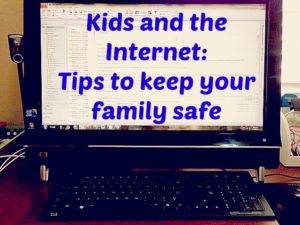My children are getting older, and I find myself trying to deal with issues that our parents didn’t have to be concerned about when we were our kids’ ages. Even just ten years ago, parents did not have to deal with iPads, Wi-Fi, and smart phones.
We try to monitor what the kids watch on TV and we don’t allow access to the Internet without adult supervision. However, with technology constantly changing, monitoring three growing children’s activities is becoming harder and harder.
There are no easy solutions, and I am still trying to navigate how to keep the children safe from strangers, ID theft, and being exposed to inappropriate content. The old rule of keeping the computer in a family-friendly location is no longer possible. The kids can now take the iPad, computer, or smart phone anywhere in the house.
These are some tips we have found useful for our family: (I see these evolving constantly as the children get older and the technology changes.)
1) We do not use their names, age, or location in any email address or login.
2) We maintain all logins and passwords. The children do not have access to this information.
3) We removed all Internet browsers from the kids’ iPad. Quite frankly, it scares me what a seemingly innocent internet query could turn up. But if your children do search online, make sure the safe mode or other parental restrictions are turned on!
4) We set up the Netflix app with the kid-only content. But even with this option, the kids can still reach adult content on the iPad or other devices without the proper restrictions activated.
5) There are so many games and apps that also include a chat function. My kids play Words with Friends, and I want them to continue this for the educational benefit, as well as being able to socialize with their friends though the chat feature. But I make sure they do not play against strangers or accept any requests from unknown people.
Many of the above-mentioned steps can be set through parental controls or other restrictions found in the settings menu of iPads or other online devices.
In addition to these steps, I regularly have conversations with the kids about why we feel the need to protect them from people and materials on the internet. By talking to the children about these things, I am hopeful that, should an incident with a stranger ever occur, they would come tell us.
But no matter what steps we take to protect them, nothing substitutes for basic parental supervision. You may have child-proofed your house from every possible danger, but you still wouldn’t leave your young child home alone. I believe this same rule applies as they mature and have access to technology.
It is a tricky balance that we have to find. I know we aren’t the only ones sometimes confused and unsure what steps to take.
What does your family do to keep your children safe while still being able to stay connected and have access to the educational and developmental benefits of technology?



















